|
|
 |
Fiche d'espèce de Copépode |
|
|
Calanoida ( Ordre ) |
|
|
|
Calanoidea ( Superfamille ) |
|
|
|
Paracalanidae ( Famille ) |
|
|
|
Paracalanus ( Genre ) |
|
|
| |
Paracalanus denudatus Sewell, 1929 (F,M) | |
| | | | | | | Syn.: | no Calanus pygmaeus Claus, 1863 (p.174) (not clear);
Paracalanus pygmaeus : Sars, 1925 (p.24, figs.F); Rose, 1929 (p.16); 1933 a (p.74, figs.F); Massuti Alzamora, 1940 (p.4); 1942 (p.110); Vervoort, 1946 (p.126); Wilson, 1942 a (p.201); Sewell, 1948 (p.400); Farran & Vervoort, 1951 c (n°35, p.3, figs.F); Marques, 1961 (p.52); Fagetti, 1962 (p.12); Grice & Hart, 1962 (p.287, 293: Rem.); Djordjevic, 1963 (p.576); Mazza, 1966 (p.69); Razouls, 1972 (p.17, figs.F); El-Sherif & Aboul Ezz, 2000 (p.61, Table 3: occurrence); Vives & Shmeleva, 2007 (p.973, figs.F,M, Rem.); Zaafa & al., 2014 (p.67, Table I, occurrence); El Arraj & al., 2017 (p.272, table 2, spatial distribution); | | | | Ref.: | | | Sewell, 1929 (p.66, Descr.F, figs.F); Farran, 1936 a (p.80, fig.F, Rem.); Sewell, 1947 (p.51, Rem.); Tanaka, 1956 c (p.368, figs.F, Rem.); 1960 (p.24, Rem.); Vervoort, 1963 b (p.106, figs.F, Rem.); De Decker, 1964 (p.16); Grice & Hulsemann, 1967 (p.14: Rem.); Corral Estrada, 1970 (p.86, Descr.M, figs.F,M, Rem.); Park, 1970 (p.475); Silas, 1972 (p.645); Kos, 1972 (Vol. I, figs.F, Rem.); Andronov, 1977 (p.154, Rem.); Vives, 1982 (p.290); Chahsavar-Archad & Razouls, 1982 (p.27); Scotto di Carlo & al., 1984 (p.1043); Alvarez-Cadena, 1985 (tab.2); Hiromi, 1987 (p.153, Rem.); Chihara & Murano, 1997 (p.845, Pl.135: F); Bradford-Grieve & al., 1999 (p.878, 910, figs.F); Avancini & al., 2006 (p.64, Pl. 33, figs.F, Rem.); Vives & Shmeleva, 2007 (p.966, figs.F,M, Rem.); Kesarkar & Anil, 2010 (Rem.: p.405, fig.F) | 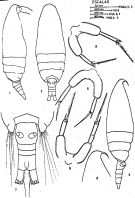 issued from : J. Corral Estrada in Tesis Doct., Univ. Madrid, A-129, Sec. Biologicas, 1970. [Lam.17]. Female (from Canarias Is.): 1, habitus (lateral right side); 2, idem (dorsal); 3, P5; 4,habitus (lateral right side, another specimen); 5, P5; 6, forehead (lateral , another specimen); 7, posterior part cephalothorax and urosome (dorsal); 8, P5.
|
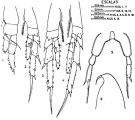 issued from : J. Corral Estrada in Tesis Doct., Univ. Madrid, A-129, Sec. Biologicas, 1970. [Lam.18, figs.1-6]. Female (another specimen): 1, P1; 2, P2; 3, P3; 4, P4; 5, P5; 6, forehead (lateral).
|
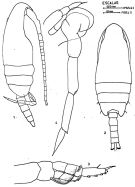 issued from : J. Corral Estrada in Tesis Doct., Univ. Madrid, A-129, Sec. Biologicas, 1970. [Lam.15]. Male: 1, habitus (lateral right side); 2, idem (dorsal); 3, P1; 4, P5.
|
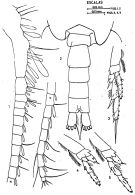 issued from : J. Corral Estrada in Tesis Doct., Univ. Madrid, A-129, Sec. Biologicas, 1970. [Lam.16]. Male: 1, A1; 2, posterior part cephalothorax and urosome (dorsal); 3, P2; 4, P4; 5, P5.
|
 issued from : R.B.S. Sewell in Mem. Indian Mus., 1929, X. [p.67, Fig.23]. Female (from Nankauri Harbour): a, habitus (lateral left side); b, urosome (dorsal); c, genital segment (ventral); d, P2; e, P3; f, P4; g, P4 (in another specimen); h, P5.
|
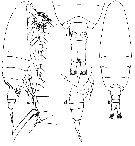 issued from : W. Vervoort in Atlantide Report., 1963, 7. [p.107, Fig.9]. Female (from off W Portugal): a-b, habitus (lateral and dorsal, respectively) (x135): c-d, posterior part cephalothorax and urosome (dorsal and lateral, respectively) (x240).
|
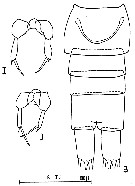 issued from : C. Razouls in Th. Doc. Etat Fac. Sc. Paris VI, 1972, Annexe. [Fig.26, B, I-J]. As Paracalanus pygmaeus. Female (from Banyuls, G. of Lion): B, urosome (dorsal); I-J, P5 (from two specimens).
|
 issued from : K.S. Kesarkar & A.C. Anil in J. mar. Biol. Ass. UK, 2010, 90 (2); [p.405, Table 2]. Characteristics of females.
|
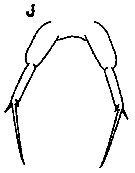 issued from : K.S. Kesarkar & A.C. Anil in J. mar. Biol. Ass. UK, 2010, 90 (2); [p.407, Fig.5, J]. Female: J, P5.
|
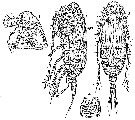 Issued from: G.O. Sars in Résult. Camp. Scient. Prince Albert I, 69, pls.1-127 (1924). [Pl.VI, figs. 1-4]. Female: 1, habitus (lateral); 2, same (dorsal); 3, forehead (lateral), showing labrum and labiums ventrally; 4, genital segment (ventral).
|
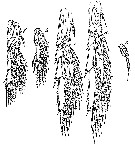 Issued from: G.O. Sars in Résult. Camp. Scient. Prince Albert I, 69, pls.1-127 (1924). [Pl.VI, figs. 5-9]. As Paracalanus pygmaeus. Female: 5, P1; 6, endopodite of P2; 7, P3; 8, P4; 9,
P5.
|
 Issued from M. Rose in Résult. Camp. scient. Prince Albert I, 1929, 78, p.16. Remarques concernant Paracalanus pygmaeus (= Paracalanus denudatus) identifié lors des campagnes de 1912, 1913 et 1914.
| | | | | Ref. compl.: | | | Sewell, 1948 (p.357, 418, 426); Ahlstrom & Thrailkill, 1963 (p.57, Table 5, abundance); De Decker, 1964 (p.16, 23, 27); Fleminger, 1967 a (tabl.1); Delalo, 1968 (p.137); Park, 1970 (p.475); Apostolopoulou, 1972 (p.327, 336); Corral Estrada & Pereiro Muñoz, 1974 (tab.I); Patel, 1975 (p.659); Judkins, 1980 (p.475, Rem.: p. 477); Vives, 1982 (p.290); Smith S.L., 1982 (p.1331, abundance, monsoon effect); Kovalev & Schmeleva, 1982 (p.83); Scotto di Carlo & al., 1984 (1043); Brinton & al., 1986 (p.228, Table 1); Madhupratap & Haridas, 1986 (p.105, tab.1); Lozano Soldevilla & al., 1988 (p.57); Othman & al., 1990 (p.561, 563, Table 1); Siokou-Frangou, 1997 (tab.1); Hure & Krsinic, 1998 (p.26, 100); Suarez-Morales & Gasca, 1998 a (p.110); Smith S. & al., 1998 (p.2369, Table 6, moonsoon effects); Ueda & al., 2000 (tab.1); Fragopoulu & al., 2001 (p.49, tab.1); Uysal & al., 2002 (p.17, tab.1); Paffenhöfer & Mazzocchi, 2003 (p.1151, fig.8); Vukanic, 2003 (139, tab.1); Rezai & al., 2004 (p.486, tab.2, 3, abundance, Rem., p.495, tab.8); Pusch & al., 2004 (251, tab.3); Shimode & Shirayama, 2004 (p.607, tab.1, 2); Smith & Madhupratap, 2005 (p.214, tab.4, 6); Rezai & al., 2005 (p.157, Table 2, 5: spatial & temporal variations); Prusova & Smith, 2005 (p.75, 78); Isari & al., 2006 (p.241, tab.II); Khelifi-Touhami & al., 2007 (p.327, Table 1); Humphrey, 2008 (p.84: Appendix A); Wishner & al., 2008 (p.163, Table 2, fig.8, oxycline); Ohtsuka & al., 2008 (p.115, Table 4); C.E. Morales & al., 2010 (p.158, Table 1: ?); Cornils & al., 2010 (p.2076, Table 3, Fig.5); Schnack-Schiel & al., 2010 (p.2064, Table 2: E Atlantic subtropical/tropical); Mazzocchi & Di Capua, 2010 (p.426); Fazeli & al., 2010 (p.153, Table 1); Maiphae & Sa-ardrit, 2011 (p.641, Table 2, 3, Rem.); Saitoh & al., 2011 (p.85, Table 5); Isari & al., 2011 (p.51, Table 2, abundance vs distribution); Selifonova, 2011 a (p.77, Table 1, alien species in Black Sea); Mazzocchi & al., 2011 (p.1163, Table II, fig.6, long-term time-series 1984-2006); Mazzocchi & al., 2012 (p.135, annual abundance 1984-2006); Uysal & Shmeleva, 2012 (p.909, Table I); DiBacco & al., 2012 (p.483, Table S1, ballast water transport); Johan & al., 2012 (p.647, Table 1, 2, salinity range); Salah S. & al., 2012 (p.155, Tableau 1); Hidalgo & al., 2012 (p.134, Table 2); Johan & al., 2012 (2013) (p.1, Table 1); Miloslavic & al., 2012 (p.165, Table 2, transect distribution); Gubanova & al., 2013 (in press, p.4, Table 2: as P. dendatus lapsus calami); Terbiyik Kurt & Polat, 2013 (p.1163, Table 2, seasonal distribution); Cornils & Blanco-Bercial, 2013 (p.861, Table 1, molecular analysis, figs.3, 4, 5); in CalCOFI regional list (MDO, Nov. 2013; M. Ohman, comm. pers.); Hirai & al., 2013 (p.1, Table I, molecular marker); Lidvanov & al., 2013 (p.290, Table 2, % composition); Pansera & al., 2014 (p.221, Table 2, abundance); Mazzocchi & al., 2014 (p.64, Table 3, 4, 5, spatial & seasonal composition %); Benedetti & al., 2016 (p.159, Table I, fig.1, functional characters); El Arraj & al., 2017 (p.272, table 2, spatial distribution); Benedetti & al., 2018 (p.1, Fig.2: ecological functional group); Belmonte, 2018 (p.273, Table I: Italian zones) | | | | NZ: | 15 | | |
|
Carte de distribution de Paracalanus denudatus par zones géographiques
|
| | | | | | | | | | | | | Loc: | | | South Africa (SE), Namibia, SE Atlant., ? G. of Guinea, off S Cape Verde Is., off Morocco-Mauritania, Cap Ghir, Great Meteor Seamount, Canary Is., Madeira Is., off Amazon, G. of Mexico, off W Tangier, Medit. (M'Diq, W Basin, Gulf of Annaba, Ligurian Sea, Tyrrhenian Sea, G. of Napoli, Lake Faro (Sicily), Adriatic Sea, Aegean Sea, Thracian Sea, Black Sea, Iskenderun Bay, Lebanon Basin), G. of Aqaba, Sharm Em-Sheikh, Red Sea, Gulf of Oman, G. of Aden, Arabian Sea, Somalia, Andaman & Nicobar Islands, NW India (Saurashtra coast), Macpherson Strait, Perai River estuary (Penang), Straits of Malacca, G. of Thailand, Malaysia (Sarawak: Bintulu coast), SW Celebes, Viet-Nam (Cauda Bay), China Seas (South China Sea, East China Sea, 24°56'N-127°59'E), Japan, Palau Is., Australia (G. of Carpentaria, Great Barrier), California, W Baja California, Gulf of California, W Mexico (Mazatlàn), Chile, off Santiago
Data from Cornils & Blanco-Bercial (2013): 28°50'N; 34°44'E. | | | | N: | 87 | | | | Lg.: | | | (14) F: 0,935-0,7; (29) F: 0,64; (34) F: 0,96-0,73; (55) F: 0,81-0,74; (66) F: 0,56; (180) F: 0,8-0,7; M: 0,745; (786) F: 0,83; {F: 0,56-0,96; M: 0,75}
The mean female size is 0.764 (n = 11; SD = 0.1193). | | | | Rem.: | épipélagique.
Pour Andronov (1977, p.154) et Bradford-Grieve (1994, p.67) cette espèce est synonyme de Paracalanus pygmaeus (Claus,1863), contrairement à l'opinion de Vervoort (1963 b, p.109) pour lequel cette dernière espèce n'est pas identifiable. Vives & Shmeleva (2007, p.673) estiment que la femelle de P. pygmaeus est différente de P. denudatus, s'appuyant sur la longueur de la soie terminale de P5 par rapport au second segment, ce qui n'emporte pas la conviction.
Voir aussi les remarques en anglais | | | Dernière mise à jour : 28/10/2022 | |
|
|
 Toute utilisation de ce site pour une publication sera mentionnée avec la référence suivante : Toute utilisation de ce site pour une publication sera mentionnée avec la référence suivante :
Razouls C., Desreumaux N., Kouwenberg J. et de Bovée F., 2005-2025. - Biodiversité des Copépodes planctoniques marins (morphologie, répartition géographique et données biologiques). Sorbonne Université, CNRS. Disponible sur http://copepodes.obs-banyuls.fr [Accédé le 30 novembre 2025] © copyright 2005-2025 Sorbonne Université, CNRS
|
|
 |
 |













